Update 4/20/12: As I've written several times, the crime problem is clearly attributable to Forest City Ratner's malls.
Is the proposed 22-acre Atlantic Yards site blighted, a precondition for the use of eminent domain? Of course, says the Empire Statement Development Corporation, in a Blight Study that is part of the General Project Plan. And one of the reasons is a high crime rate--a manipulative allegation that crumbles under scrutiny.
 Notably, in two of the three sectors studied that each included parts of the footprint, the crime rate was lower last year than in the larger police precincts they belong to. In the third of the sectors, the rate was dramatically higher than in the larger police precinct. That raised the average crime rate of the three sectors high enough to suggest that the footprint as a whole has a crime problem. (At right, the broad boundaries of the three affected precincts. Click on any graphic for a larger view.)
Notably, in two of the three sectors studied that each included parts of the footprint, the crime rate was lower last year than in the larger police precincts they belong to. In the third of the sectors, the rate was dramatically higher than in the larger police precinct. That raised the average crime rate of the three sectors high enough to suggest that the footprint as a whole has a crime problem. (At right, the broad boundaries of the three affected precincts. Click on any graphic for a larger view.)
But it's a suggestion, not a conclusion, since the evidence is sketchy. The New York Police Department does not keep statistics on a block-by-block level, so the consultants writing the blight report were forced to generalize. Worse, they ignored other factors beyond the footprint that might contribute to crime in the sector they identified.
But the alleged crime problem is already part of Forest City Ratner's talking points. "The crime in these areas is substantially higher than areas around it," Jim Stuckey, president of the Atlantic Yards Development Group, told WNYC talk show host Brian Lehrer.
Finding the crime
The study, which I'll quote in full, begins:
As described in Sections B and C of this report, the project site is characterized by blighted conditions including an active but open and below-grade rail yard, vacant lots, vacant buildings, unsanitary and unsafe conditions, and buildings that are structurally unsound. An analysis of crime statistics compiled by the NYPD indicates that the project site is also characterized by high crime rates, another indicator of blighted conditions. As discussed below, 2004 and 2005 crime data indicate that per capita crime rates on the project site and in surrounding blocks are higher than for the broader precincts in which the project site is located.
The first red flag is the term "per capita crime rates on the project site and in surrounding blocks." This signals that we just don't know the crime rates on the project site.
 The study continues:
The study continues:
As shown in Figure 8, the project site overlaps three New York City Police Department (NYPD) precincts. The northern portion of the project site, including Blocks 927, 1118, 1119, 1120, and 1121, is located in the 88th precinct. The southern portion of the project site is divided between the 77th and 78th precincts, with Blocks 1128 and 1129 located in the 77th precinct and Block 1127 located in the 78th precinct. For crime reporting purposes, the NYPD divides each precinct into groups of blocks called “sectors.” As shown in Figure 9, the three sectors that cover the project site are: sector A in the 77th precinct; sector D in the 78th precinct; and sector E in the 88th precinct.
Generalizations needed
Given the constraints on statistics, the study has to generalize:
Sectors are the smallest geographic area for which the NYPD publishes crime data. Therefore, it is not possible to determine the number of crimes that have occurred on the project site itself. However, crime rates in the sectors that overlap the project site (referred to here as the study area) can be compared to precinct averages to determine whether there are any substantial differences between crime rates on and around the project site and crime rates in the larger precincts. Table D-1 presents this comparison for 2004 and 2005, the most recent years for which annual crime data is available.
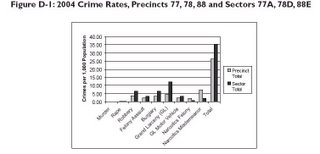 Yes, the crime rate is higher than in the larger precincts, but only if it's presented collectively, thus blurring the three distinct sectors:
Yes, the crime rate is higher than in the larger precincts, but only if it's presented collectively, thus blurring the three distinct sectors:
As shown in the table and illustrated in Figures D-1 and D-2, the total crime rate for the study area (sectors 77A, 78D, and 88D) was substantially higher than the total crime rate for the larger three-precinct area (precincts 77, 78, and 88) in both 2004 and 2005. In 2004, the total crime rate for the study area (35.4 crimes per 1,000 persons) was approximately 34 percent higher than the crime rate for the larger precinct area (26.4 crimes per 1,000 persons).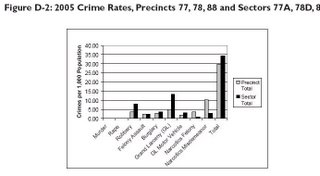 Although the total crime rate for the study area decreased slightly between 2004 and 2005 (from 35.4 to 34.3 crimes per 1,000 persons), it was still approximately 16 percent higher than the crime rate for the three-precinct area (29.6 crimes per 1,000 persons).
Although the total crime rate for the study area decreased slightly between 2004 and 2005 (from 35.4 to 34.3 crimes per 1,000 persons), it was still approximately 16 percent higher than the crime rate for the three-precinct area (29.6 crimes per 1,000 persons).
So the crime rate, actually, went down between 2004 and 2005. Does that mean it's trending ever downward and would work itself out?
How meaningful is a 16 percent difference in the crime rate? In some states, where they're taking another look at eminent domain, that wouldn't make a ripple. Recently passed legislation in Wisconsin constraining the use of eminent domain, for example, requires "The crime rate in, on, or adjacent to the property is at least 3 times the crime rate in the remainder of the municipality in which the property is located."
 How much crime?
How much crime?
It's worth taking a close look at the detailed crime report. It shows that, in the two sectors incorporating blocks in the southern portion of the project footprint, 77A and 78D, the crime rate was lower than in each of the larger precincts in 2005. The crime rate in 77A in 2004 was lower than in the precinct as a whole, while the crime rate in 78D was less than 10 percent higher than in the precinct as a whole.
The dramatic differences can be attributed to sector 88E, which incorporates the blocks in the northern portion of the project footprint--plus a whole lot more. (Click to enlarge.)

Even though one sector can be blamed for the crime increase, the study persists in grouping the three sectors together:
Crime rates for categories of crime such as robbery and grand larceny increased more substantially in the study area than in the overall three-precinct area. As described below, the data presented in Table D-1 indicate that the lack of street-level activity on the project site and the relative isolation of the project site from busier pedestrian streets such as 5th Avenue, Fulton Street, and the western portion of Atlantic Avenue creates an environment that is conducive to illegal activities. The higher crime rates for the precinct sectors encompassing the project site indicate that residents and businesses in the area are more susceptible to crime.
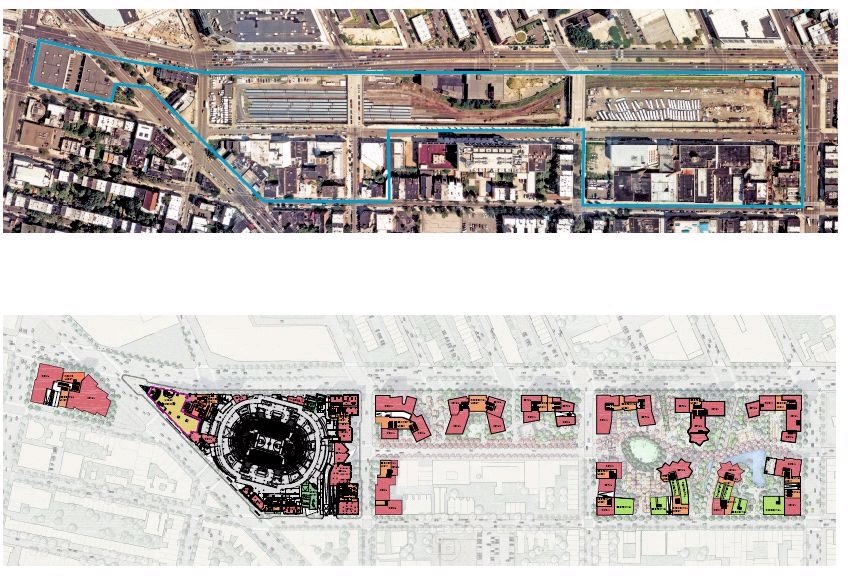 How exactly are they sure? The increase in crime in Sector 88E cannot be blamed on the project site. And there are very few residents and businesses in that northern portion of the project site, as the overhead photo shows. It consists of the railyard, a bus storage area, and a few businesses, including the P.C. Richard/Modell's at Site 5 at the far west end.
How exactly are they sure? The increase in crime in Sector 88E cannot be blamed on the project site. And there are very few residents and businesses in that northern portion of the project site, as the overhead photo shows. It consists of the railyard, a bus storage area, and a few businesses, including the P.C. Richard/Modell's at Site 5 at the far west end.
Fudging the difference
The report does acknowledge the distinction between sectors, though it doesn't point out that two of three sectors are safer than the larger precincts in which they're located:
Differences in crime rates were most notable in the 88th precinct, which covers the bulk of the project site, including the rail yard. As shown in Table D-1, the total crime rate for sector 88E was over three times the rate for precinct 88 in both 2004 and 2005. In 2004 and 2005, the crime rates for sector 88E were 58.2 crimes and 65.1 crimes per 1,000 persons, respectively. In contrast, the crime rate for precinct 88 was only 18.2 crimes per 1,000 persons in 2004 and 19.6 crimes per 1,000 persons in 2005.
Imposing assumptions
The report continues with some assumptions about the source of the crime:
As indicated above, it is not possible to isolate crimes that have occurred within the project site boundaries. However, because five of the twelve blocks that comprise sector 88E are part of the project site it is reasonable to assume that crime rates on at least this portion of the project site are significantly higher than average. Given the physical characteristics of the project site, this high crime rate is not surprising.
So this portion of the project site has a high crime rate but the adjacent blocks don't? It doesn't add up. How does the population of these five blocks compare to the population of sector 88E as a whole? We're not told.
The report then blames the apparent high crime rate in sector 88E and the northern section of the project site on the conditions in the project site as a whole:
Night time lighting around the project site is low or non-existent – in part due to the high number of properties that are vacant and in part due to the physical characteristics of the project site and the buildings on the site. Not only are there not many uses to give off light, there are few surfaces, such as building façades, that could reflect light. Large areas of the project site that are part of the depressed rail yard have minimal lighting in their central volumes and seem to make the area even darker.
Note that the most of the buildings in the project site are not in sector 88E but in the other two sectors. So the claim is a fudge--why would the vacant buildings in part of the project site be responsible for high crime across the street, but not on the sidewalks outside?
Drug dealing and auto theft
The study suggests that the project site is a haven for drug dealing and auto theft:
The lack of adequate lighting, presence of deteriorating built structures and vacant lots, and lack of street-level activity creates a sense of isolation that may encourage illegal activity. In 2004, the NYPD recorded 5.2 narcotics misdemeanors per 1,000 persons in sector 88E. This rate was approximately 40 percent higher than the rate for precinct 88 (3.7 narcotics misdemeanors per 1,000 persons). In 2005, the rate for sector 88E increased to 5.8 narcotics misdemeanors per 1,000 persons. This crime rate was approximately 18 percent higher than the rate for the 88th precinct (4.9 narcotics misdemeanors per 1,000 persons).
Similarly, the 2004 crime rate for motor vehicle grand larceny was over three times as high in sector 88E than in the 88th precinct, and the 2005 rate for the sector was more than double the rate for the precinct. The lack of pedestrian activity and relative isolation and desolate feeling on the project site, particularly on Pacific Street south of the rail yard, creates an environment that is conducive to activities such as automobile theft and drug sales.
Given that the precinct boundary is in the middle of Pacific Street, this seems to be suggesting that the isolation on the northern side of the block--which is a brushy area bordering a fence guarding the railyards--fosters much more crime than across the street. Is that where the drug dealers hang out?
The irony, of course, is that eminent domain would not be needed to solve any apparent blight caused by the railyard site. All that's necessary is for the Metropolitan Transportation Authority to make improvements or to put the property out for bid.
Eminent domain would be used mainly to acquire properties in the two sectors with a lower crime rate than the precincts they are within.
Not the malls
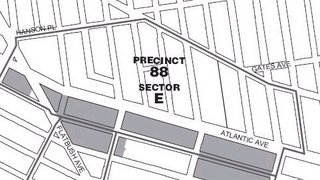 The report assesses whether Forest City Ratner's two malls, in the western end of Sector 88E, contribute to crime:
The report assesses whether Forest City Ratner's two malls, in the western end of Sector 88E, contribute to crime:
The Atlantic Center and Atlantic Terminal shopping centers are located immediately north of the project site, also within the boundaries of Sector 88E. In an effort to determine whether a large proportion of crimes reported for Sector 88E might have occurred on the Atlantic Center/Atlantic Terminal premises rather than on the project site, crime data were obtained from the security staff at the shopping centers.
Based on this data, which reflects incidents occurring within the Atlantic Center and Atlantic Terminal shopping and parking areas as well as on the surrounding sidewalks, it is unlikely that a large proportion of crimes in sector 88E occurred on the Atlantic Center or Atlantic Terminal premises. For example, while there were 39 robberies in sector 88E in 2005, the shopping center security records indicate that no robberies occurred that year at Atlantic Center or Atlantic Terminal. Similarly, while there were 115 grand larceny crimes reported for sector 88E in 2005, the shopping center security force recorded only one incident of larceny that same year. Although crimes catalogued by the Atlantic Center and Atlantic Terminal security staff are not necessarily the same as those catalogued by the NYPD, the relatively low number of crimes reported at the shopping centers indicates that the high crime rate in sector 88E is more likely a result of crimes occurring on the project site than in Atlantic Center or Atlantic Terminal.
(Emphasis added)
FCR's blight?
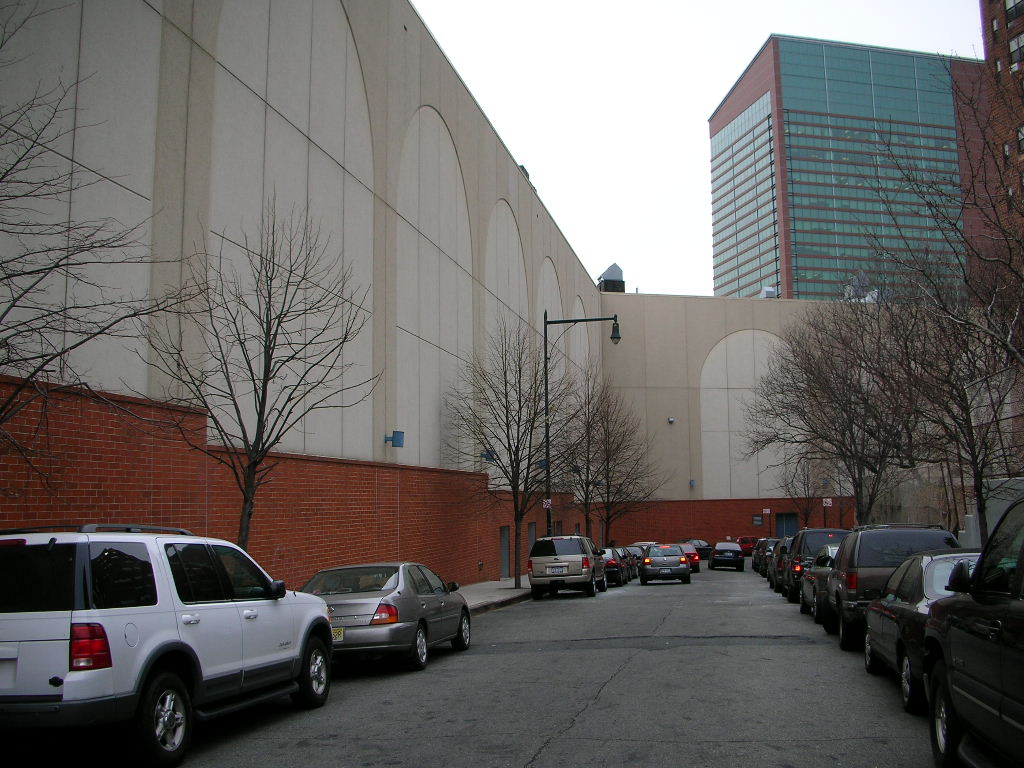 However, the report makes no attempt to assess whether the Atlantic Center mall contributes to a higher crime rate at its exterior. The blank wall along half of the building's perimeter discourages street life. Planner Ron Shiffman has called the mall "a failed design with a limited life expectancy that constitutes a major blighting on the border of Fort Greene."
However, the report makes no attempt to assess whether the Atlantic Center mall contributes to a higher crime rate at its exterior. The blank wall along half of the building's perimeter discourages street life. Planner Ron Shiffman has called the mall "a failed design with a limited life expectancy that constitutes a major blighting on the border of Fort Greene."
Similarly, it does not assess whether the blank walls around the retail structures at Forest City Ratner's Site 5 foster crime. The General Project Plan looks disparagingly at Site 5, calling it "significantly underutilized," as "Blank walls with no glazing and few breaks or entrances abut four public streets."
Other locations with crime?
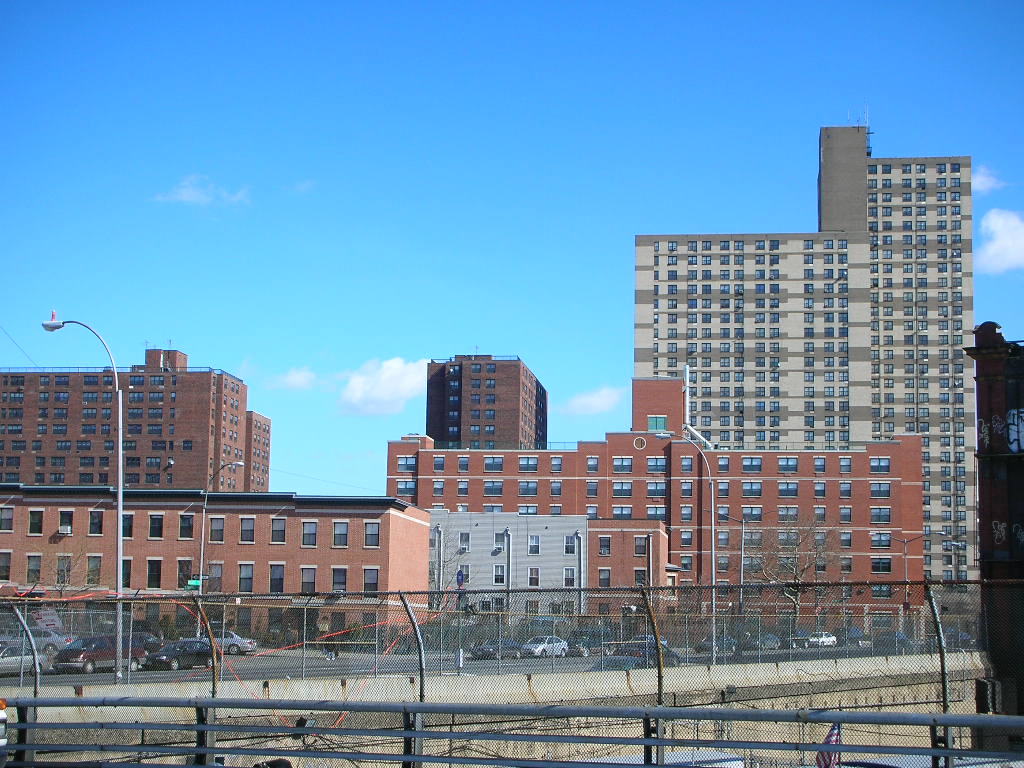 More importantly, the report improperly suggests that there are only two sources of potential crime within sector 88E: Forest City Ratner's two malls or the northern blocks of the project footprint. As the map above indicates, sector 88E contains several other blocks north of the footprint and east of the mall. One large block, for example, contains Atlantic Terminal Site 4B, the tallest residential property in the city public housing stock (right).
More importantly, the report improperly suggests that there are only two sources of potential crime within sector 88E: Forest City Ratner's two malls or the northern blocks of the project footprint. As the map above indicates, sector 88E contains several other blocks north of the footprint and east of the mall. One large block, for example, contains Atlantic Terminal Site 4B, the tallest residential property in the city public housing stock (right).
Is there a higher crime rate around the housing project--which has an outdated and isolating tower-in-a-park design--than in the precinct as a whole? Is there a higher crime rate in any of the other blocks within sector 88E?
We don't know. But we do know that the researchers writing the blight report should have asked more questions before assigning blame to the project site.
Is the proposed 22-acre Atlantic Yards site blighted, a precondition for the use of eminent domain? Of course, says the Empire Statement Development Corporation, in a Blight Study that is part of the General Project Plan. And one of the reasons is a high crime rate--a manipulative allegation that crumbles under scrutiny.
 Notably, in two of the three sectors studied that each included parts of the footprint, the crime rate was lower last year than in the larger police precincts they belong to. In the third of the sectors, the rate was dramatically higher than in the larger police precinct. That raised the average crime rate of the three sectors high enough to suggest that the footprint as a whole has a crime problem. (At right, the broad boundaries of the three affected precincts. Click on any graphic for a larger view.)
Notably, in two of the three sectors studied that each included parts of the footprint, the crime rate was lower last year than in the larger police precincts they belong to. In the third of the sectors, the rate was dramatically higher than in the larger police precinct. That raised the average crime rate of the three sectors high enough to suggest that the footprint as a whole has a crime problem. (At right, the broad boundaries of the three affected precincts. Click on any graphic for a larger view.)But it's a suggestion, not a conclusion, since the evidence is sketchy. The New York Police Department does not keep statistics on a block-by-block level, so the consultants writing the blight report were forced to generalize. Worse, they ignored other factors beyond the footprint that might contribute to crime in the sector they identified.
But the alleged crime problem is already part of Forest City Ratner's talking points. "The crime in these areas is substantially higher than areas around it," Jim Stuckey, president of the Atlantic Yards Development Group, told WNYC talk show host Brian Lehrer.
Finding the crime
The study, which I'll quote in full, begins:
As described in Sections B and C of this report, the project site is characterized by blighted conditions including an active but open and below-grade rail yard, vacant lots, vacant buildings, unsanitary and unsafe conditions, and buildings that are structurally unsound. An analysis of crime statistics compiled by the NYPD indicates that the project site is also characterized by high crime rates, another indicator of blighted conditions. As discussed below, 2004 and 2005 crime data indicate that per capita crime rates on the project site and in surrounding blocks are higher than for the broader precincts in which the project site is located.
The first red flag is the term "per capita crime rates on the project site and in surrounding blocks." This signals that we just don't know the crime rates on the project site.
 The study continues:
The study continues:As shown in Figure 8, the project site overlaps three New York City Police Department (NYPD) precincts. The northern portion of the project site, including Blocks 927, 1118, 1119, 1120, and 1121, is located in the 88th precinct. The southern portion of the project site is divided between the 77th and 78th precincts, with Blocks 1128 and 1129 located in the 77th precinct and Block 1127 located in the 78th precinct. For crime reporting purposes, the NYPD divides each precinct into groups of blocks called “sectors.” As shown in Figure 9, the three sectors that cover the project site are: sector A in the 77th precinct; sector D in the 78th precinct; and sector E in the 88th precinct.
Generalizations needed
Given the constraints on statistics, the study has to generalize:
Sectors are the smallest geographic area for which the NYPD publishes crime data. Therefore, it is not possible to determine the number of crimes that have occurred on the project site itself. However, crime rates in the sectors that overlap the project site (referred to here as the study area) can be compared to precinct averages to determine whether there are any substantial differences between crime rates on and around the project site and crime rates in the larger precincts. Table D-1 presents this comparison for 2004 and 2005, the most recent years for which annual crime data is available.
 Yes, the crime rate is higher than in the larger precincts, but only if it's presented collectively, thus blurring the three distinct sectors:
Yes, the crime rate is higher than in the larger precincts, but only if it's presented collectively, thus blurring the three distinct sectors:As shown in the table and illustrated in Figures D-1 and D-2, the total crime rate for the study area (sectors 77A, 78D, and 88D) was substantially higher than the total crime rate for the larger three-precinct area (precincts 77, 78, and 88) in both 2004 and 2005. In 2004, the total crime rate for the study area (35.4 crimes per 1,000 persons) was approximately 34 percent higher than the crime rate for the larger precinct area (26.4 crimes per 1,000 persons).
 Although the total crime rate for the study area decreased slightly between 2004 and 2005 (from 35.4 to 34.3 crimes per 1,000 persons), it was still approximately 16 percent higher than the crime rate for the three-precinct area (29.6 crimes per 1,000 persons).
Although the total crime rate for the study area decreased slightly between 2004 and 2005 (from 35.4 to 34.3 crimes per 1,000 persons), it was still approximately 16 percent higher than the crime rate for the three-precinct area (29.6 crimes per 1,000 persons). So the crime rate, actually, went down between 2004 and 2005. Does that mean it's trending ever downward and would work itself out?
How meaningful is a 16 percent difference in the crime rate? In some states, where they're taking another look at eminent domain, that wouldn't make a ripple. Recently passed legislation in Wisconsin constraining the use of eminent domain, for example, requires "The crime rate in, on, or adjacent to the property is at least 3 times the crime rate in the remainder of the municipality in which the property is located."
 How much crime?
How much crime?It's worth taking a close look at the detailed crime report. It shows that, in the two sectors incorporating blocks in the southern portion of the project footprint, 77A and 78D, the crime rate was lower than in each of the larger precincts in 2005. The crime rate in 77A in 2004 was lower than in the precinct as a whole, while the crime rate in 78D was less than 10 percent higher than in the precinct as a whole.
The dramatic differences can be attributed to sector 88E, which incorporates the blocks in the northern portion of the project footprint--plus a whole lot more. (Click to enlarge.)

Even though one sector can be blamed for the crime increase, the study persists in grouping the three sectors together:
Crime rates for categories of crime such as robbery and grand larceny increased more substantially in the study area than in the overall three-precinct area. As described below, the data presented in Table D-1 indicate that the lack of street-level activity on the project site and the relative isolation of the project site from busier pedestrian streets such as 5th Avenue, Fulton Street, and the western portion of Atlantic Avenue creates an environment that is conducive to illegal activities. The higher crime rates for the precinct sectors encompassing the project site indicate that residents and businesses in the area are more susceptible to crime.
 How exactly are they sure? The increase in crime in Sector 88E cannot be blamed on the project site. And there are very few residents and businesses in that northern portion of the project site, as the overhead photo shows. It consists of the railyard, a bus storage area, and a few businesses, including the P.C. Richard/Modell's at Site 5 at the far west end.
How exactly are they sure? The increase in crime in Sector 88E cannot be blamed on the project site. And there are very few residents and businesses in that northern portion of the project site, as the overhead photo shows. It consists of the railyard, a bus storage area, and a few businesses, including the P.C. Richard/Modell's at Site 5 at the far west end.Fudging the difference
The report does acknowledge the distinction between sectors, though it doesn't point out that two of three sectors are safer than the larger precincts in which they're located:
Differences in crime rates were most notable in the 88th precinct, which covers the bulk of the project site, including the rail yard. As shown in Table D-1, the total crime rate for sector 88E was over three times the rate for precinct 88 in both 2004 and 2005. In 2004 and 2005, the crime rates for sector 88E were 58.2 crimes and 65.1 crimes per 1,000 persons, respectively. In contrast, the crime rate for precinct 88 was only 18.2 crimes per 1,000 persons in 2004 and 19.6 crimes per 1,000 persons in 2005.
Imposing assumptions
The report continues with some assumptions about the source of the crime:
As indicated above, it is not possible to isolate crimes that have occurred within the project site boundaries. However, because five of the twelve blocks that comprise sector 88E are part of the project site it is reasonable to assume that crime rates on at least this portion of the project site are significantly higher than average. Given the physical characteristics of the project site, this high crime rate is not surprising.
So this portion of the project site has a high crime rate but the adjacent blocks don't? It doesn't add up. How does the population of these five blocks compare to the population of sector 88E as a whole? We're not told.
The report then blames the apparent high crime rate in sector 88E and the northern section of the project site on the conditions in the project site as a whole:
Night time lighting around the project site is low or non-existent – in part due to the high number of properties that are vacant and in part due to the physical characteristics of the project site and the buildings on the site. Not only are there not many uses to give off light, there are few surfaces, such as building façades, that could reflect light. Large areas of the project site that are part of the depressed rail yard have minimal lighting in their central volumes and seem to make the area even darker.
Note that the most of the buildings in the project site are not in sector 88E but in the other two sectors. So the claim is a fudge--why would the vacant buildings in part of the project site be responsible for high crime across the street, but not on the sidewalks outside?
Drug dealing and auto theft
The study suggests that the project site is a haven for drug dealing and auto theft:
The lack of adequate lighting, presence of deteriorating built structures and vacant lots, and lack of street-level activity creates a sense of isolation that may encourage illegal activity. In 2004, the NYPD recorded 5.2 narcotics misdemeanors per 1,000 persons in sector 88E. This rate was approximately 40 percent higher than the rate for precinct 88 (3.7 narcotics misdemeanors per 1,000 persons). In 2005, the rate for sector 88E increased to 5.8 narcotics misdemeanors per 1,000 persons. This crime rate was approximately 18 percent higher than the rate for the 88th precinct (4.9 narcotics misdemeanors per 1,000 persons).
Similarly, the 2004 crime rate for motor vehicle grand larceny was over three times as high in sector 88E than in the 88th precinct, and the 2005 rate for the sector was more than double the rate for the precinct. The lack of pedestrian activity and relative isolation and desolate feeling on the project site, particularly on Pacific Street south of the rail yard, creates an environment that is conducive to activities such as automobile theft and drug sales.
Given that the precinct boundary is in the middle of Pacific Street, this seems to be suggesting that the isolation on the northern side of the block--which is a brushy area bordering a fence guarding the railyards--fosters much more crime than across the street. Is that where the drug dealers hang out?
The irony, of course, is that eminent domain would not be needed to solve any apparent blight caused by the railyard site. All that's necessary is for the Metropolitan Transportation Authority to make improvements or to put the property out for bid.
Eminent domain would be used mainly to acquire properties in the two sectors with a lower crime rate than the precincts they are within.
Not the malls
 The report assesses whether Forest City Ratner's two malls, in the western end of Sector 88E, contribute to crime:
The report assesses whether Forest City Ratner's two malls, in the western end of Sector 88E, contribute to crime:The Atlantic Center and Atlantic Terminal shopping centers are located immediately north of the project site, also within the boundaries of Sector 88E. In an effort to determine whether a large proportion of crimes reported for Sector 88E might have occurred on the Atlantic Center/Atlantic Terminal premises rather than on the project site, crime data were obtained from the security staff at the shopping centers.
Based on this data, which reflects incidents occurring within the Atlantic Center and Atlantic Terminal shopping and parking areas as well as on the surrounding sidewalks, it is unlikely that a large proportion of crimes in sector 88E occurred on the Atlantic Center or Atlantic Terminal premises. For example, while there were 39 robberies in sector 88E in 2005, the shopping center security records indicate that no robberies occurred that year at Atlantic Center or Atlantic Terminal. Similarly, while there were 115 grand larceny crimes reported for sector 88E in 2005, the shopping center security force recorded only one incident of larceny that same year. Although crimes catalogued by the Atlantic Center and Atlantic Terminal security staff are not necessarily the same as those catalogued by the NYPD, the relatively low number of crimes reported at the shopping centers indicates that the high crime rate in sector 88E is more likely a result of crimes occurring on the project site than in Atlantic Center or Atlantic Terminal.
(Emphasis added)
FCR's blight?
 However, the report makes no attempt to assess whether the Atlantic Center mall contributes to a higher crime rate at its exterior. The blank wall along half of the building's perimeter discourages street life. Planner Ron Shiffman has called the mall "a failed design with a limited life expectancy that constitutes a major blighting on the border of Fort Greene."
However, the report makes no attempt to assess whether the Atlantic Center mall contributes to a higher crime rate at its exterior. The blank wall along half of the building's perimeter discourages street life. Planner Ron Shiffman has called the mall "a failed design with a limited life expectancy that constitutes a major blighting on the border of Fort Greene."Similarly, it does not assess whether the blank walls around the retail structures at Forest City Ratner's Site 5 foster crime. The General Project Plan looks disparagingly at Site 5, calling it "significantly underutilized," as "Blank walls with no glazing and few breaks or entrances abut four public streets."
Other locations with crime?
 More importantly, the report improperly suggests that there are only two sources of potential crime within sector 88E: Forest City Ratner's two malls or the northern blocks of the project footprint. As the map above indicates, sector 88E contains several other blocks north of the footprint and east of the mall. One large block, for example, contains Atlantic Terminal Site 4B, the tallest residential property in the city public housing stock (right).
More importantly, the report improperly suggests that there are only two sources of potential crime within sector 88E: Forest City Ratner's two malls or the northern blocks of the project footprint. As the map above indicates, sector 88E contains several other blocks north of the footprint and east of the mall. One large block, for example, contains Atlantic Terminal Site 4B, the tallest residential property in the city public housing stock (right).Is there a higher crime rate around the housing project--which has an outdated and isolating tower-in-a-park design--than in the precinct as a whole? Is there a higher crime rate in any of the other blocks within sector 88E?
We don't know. But we do know that the researchers writing the blight report should have asked more questions before assigning blame to the project site.
Comments
Post a Comment